Abstract
The region of plasmid NR1 concerned with resistance to Hg2+ and organomercurials consists of sequences found on restriction endonuclease fragments EcoRI-H and EcoRI-I. When both fragments were cloned together into a derivative of plasmid ColE1, the hybrid plasmid conferred properties indistinguishable from those of the parental plasmid, NR1: resistance to Hg2+ and to the organomercurials merbromin and fluoresceinmercuric acetate and the inducible synthesis of the enzyme mercuric reductase. When fragment EcoRI-I was cloned into plasmid ColE1, cells containing the plasmid was as sensitive to Hg2+ and organomercurials as plasmidless strains. When fragment EcoRI-H was cloned into ColE1, cells with the hybrid plasmid were hypersensitive to Hg2+ and organomercurials. This hypersensitivity was inducible by prior exposure to low, subtoxic Hg2+ or merbromin levels. It was associated with an inducible hyperbinding activity attributed to a gene governing Hg2+ uptake and found on fragment EcoRI-H (which contains the proximal portion of a mercuric resistance [mer] operon).
Full text
PDF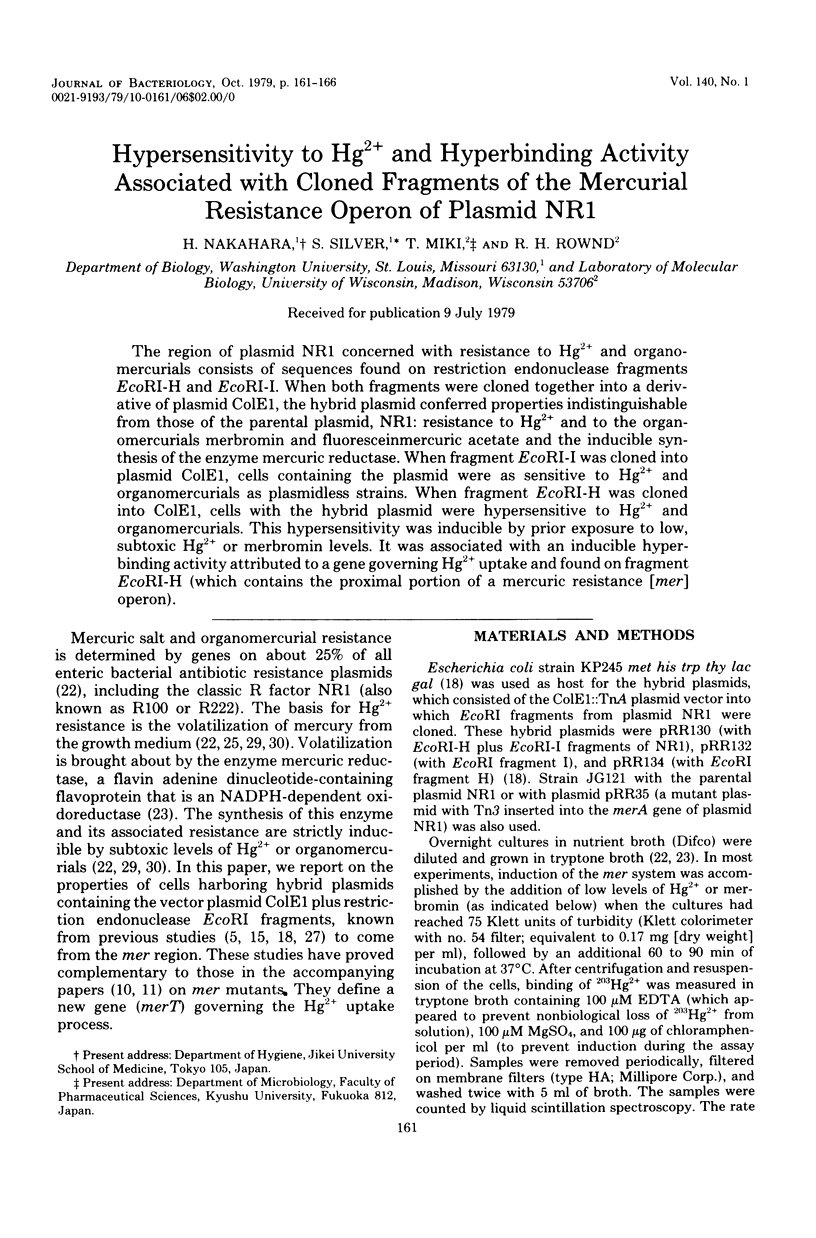
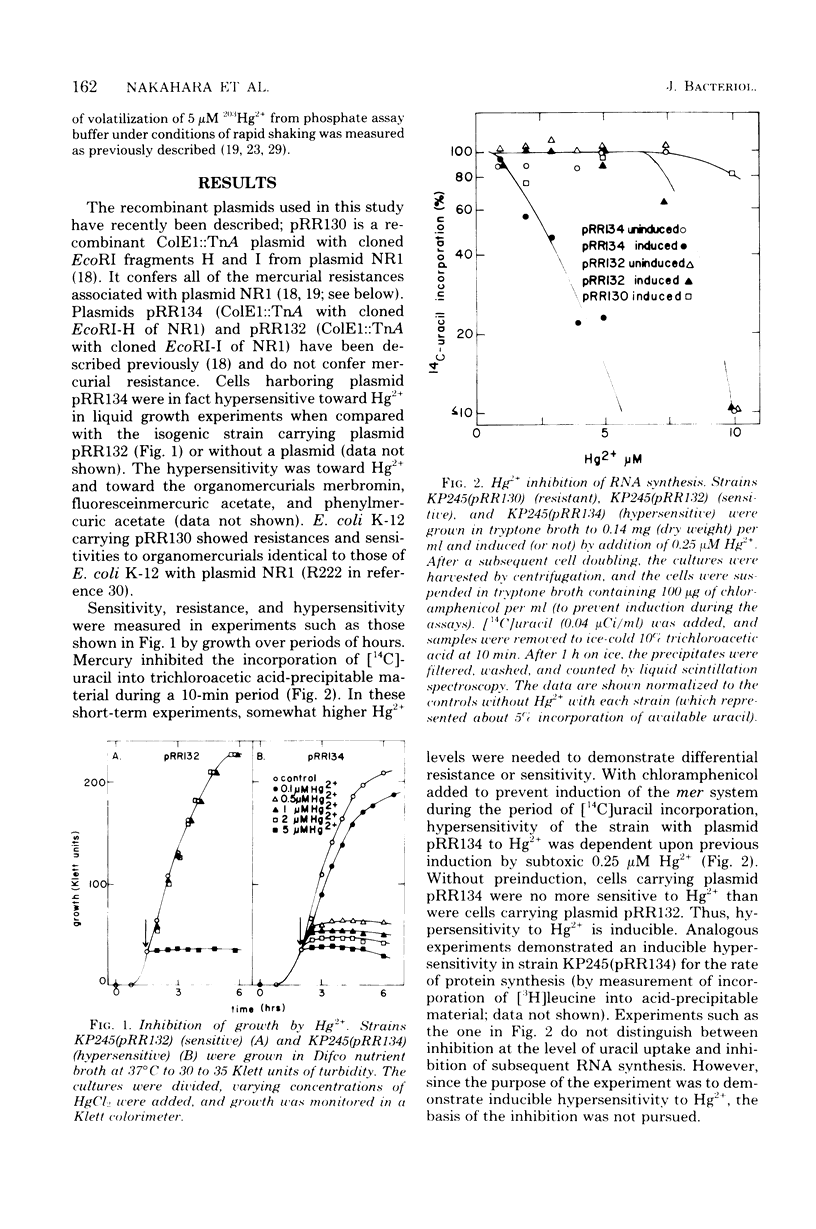
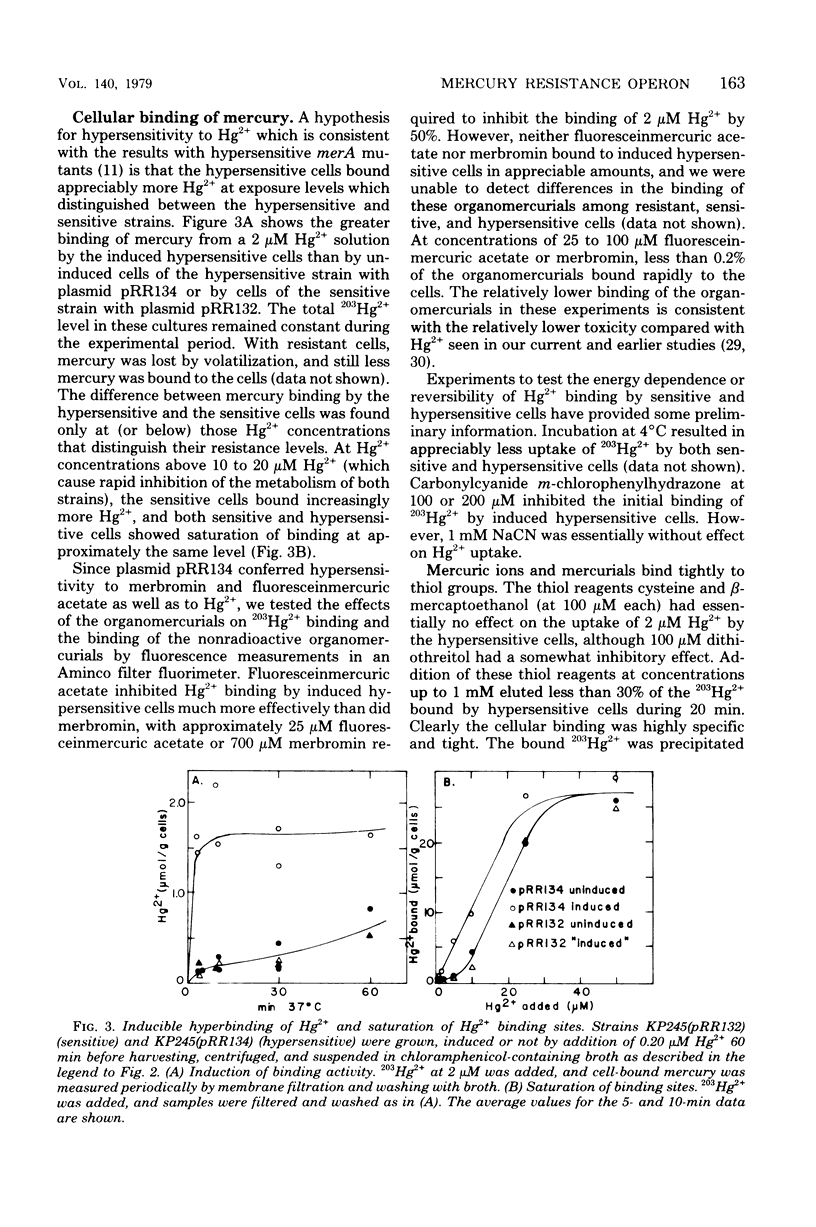
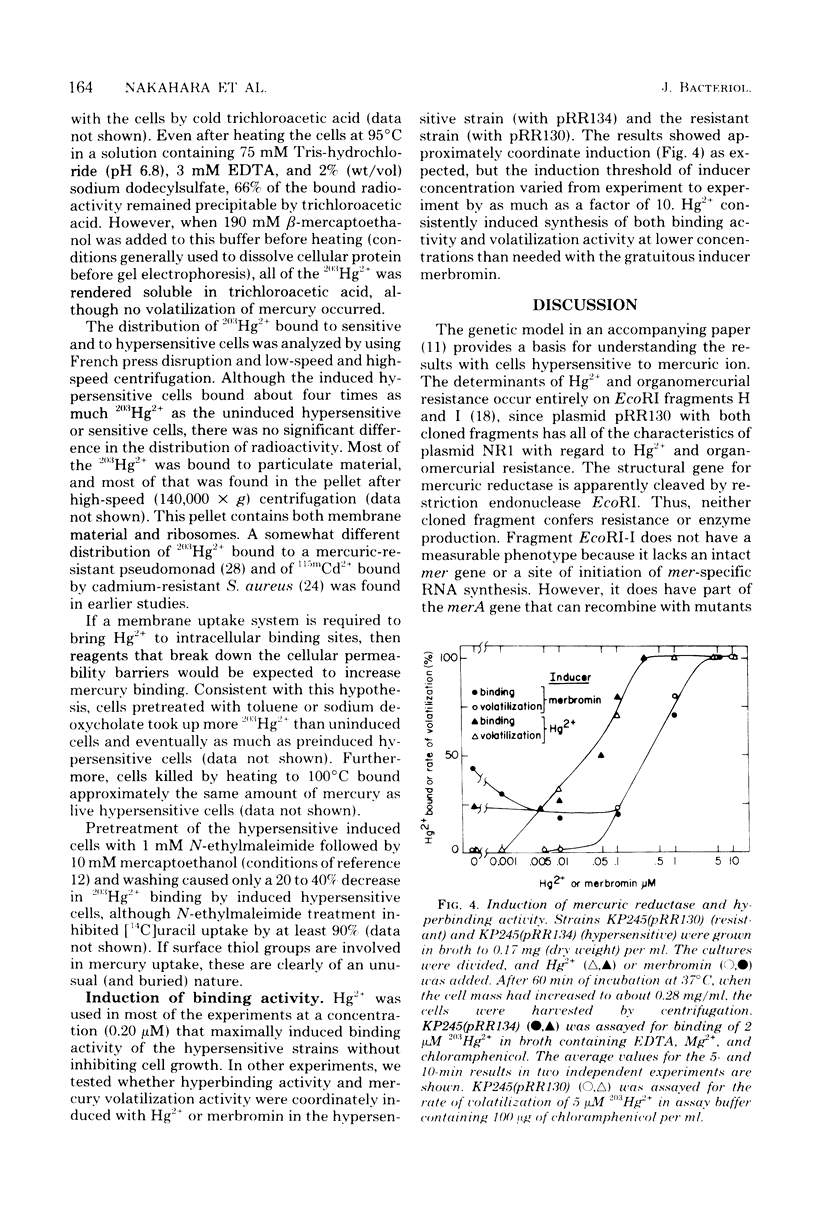
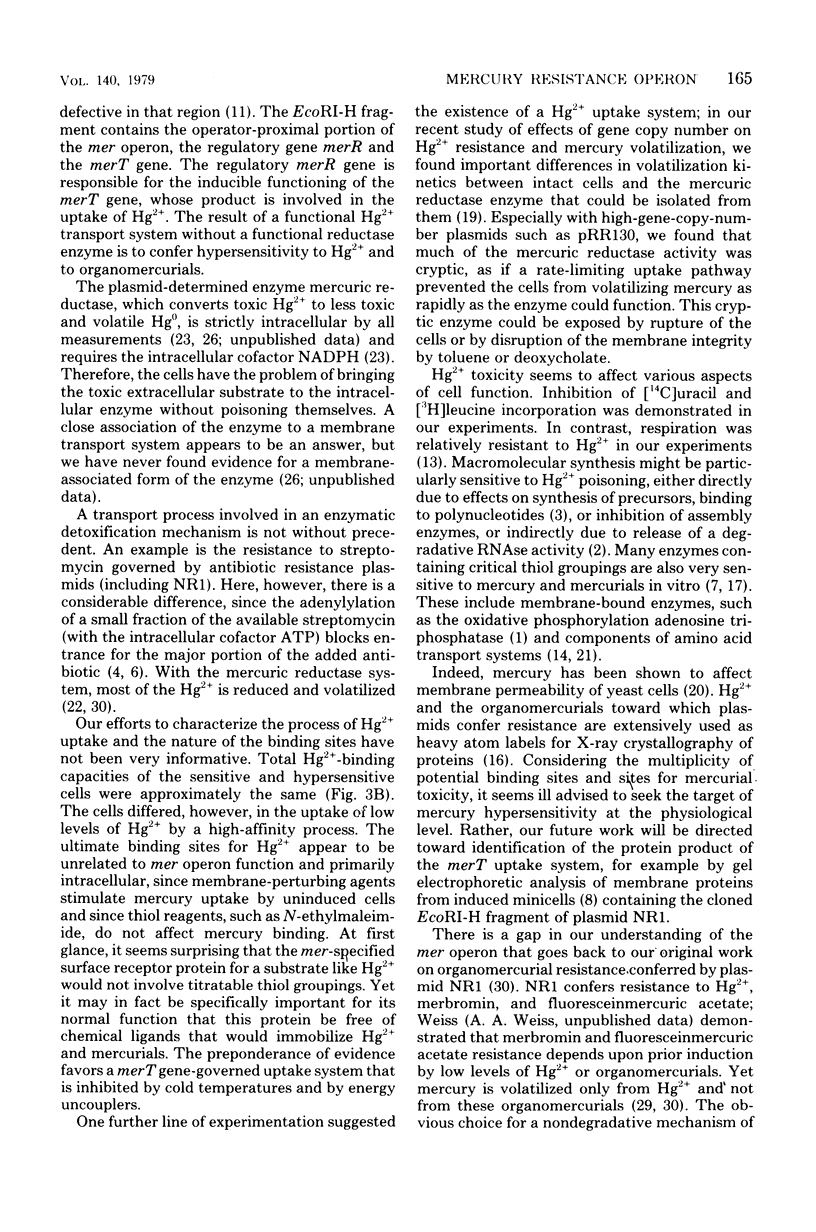
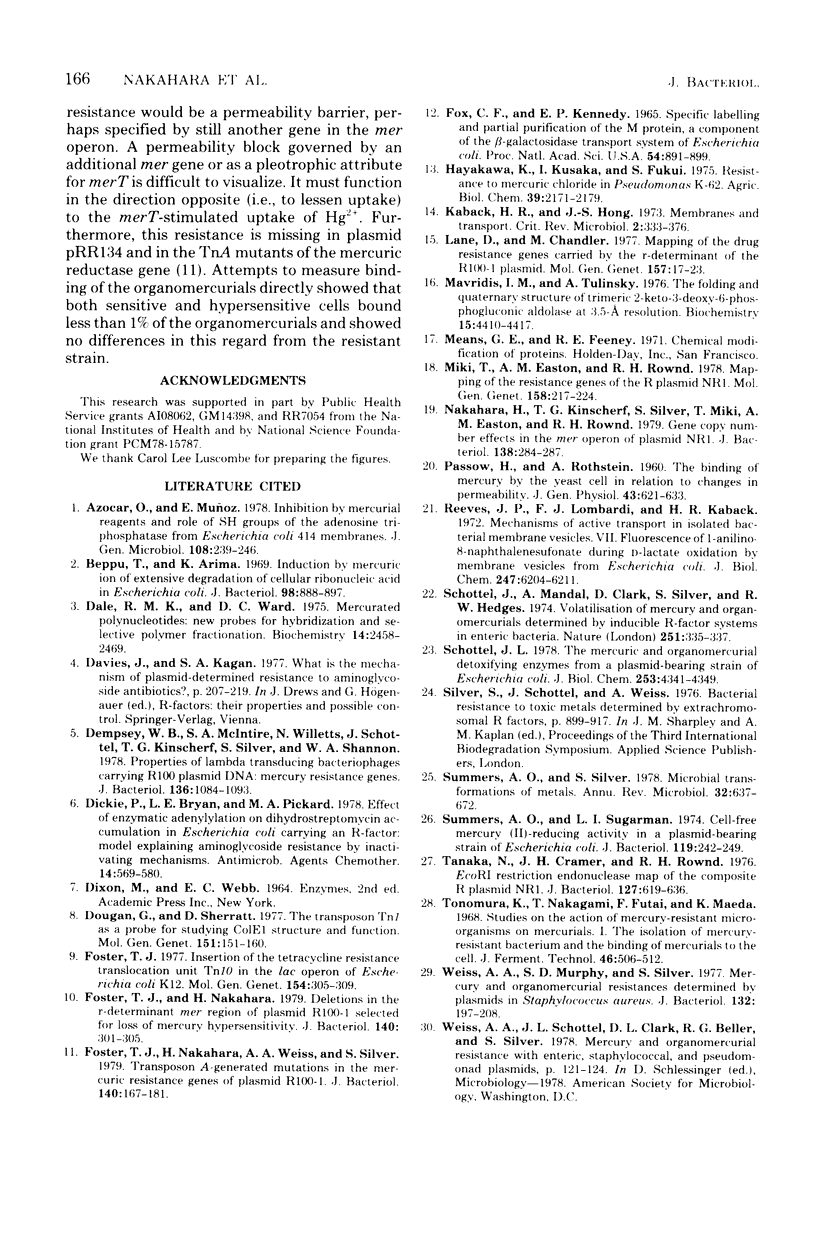
Selected References
These references are in PubMed. This may not be the complete list of references from this article.
- Beppu T., Arima K. Induction by mercuric ion of extensive degradation of cellular ribonucleic acid in Escherichia coli. J Bacteriol. 1969 Jun;98(3):888–897. doi: 10.1128/jb.98.3.888-897.1969. [DOI] [PMC free article] [PubMed] [Google Scholar]
- Dale R. M., Ward D. C. Mercurated polynucleotides: new probes for hybridization and selective polymer fractionation. Biochemistry. 1975 Jun 3;14(11):2458–2469. doi: 10.1021/bi00682a028. [DOI] [PubMed] [Google Scholar]
- Dempsey W. B., McIntire S. A., Willetts N., Schottel J., Kinscherf T. G., Silver S., Shannon W. A., Jr Properties of lambda transducing bacteriophages carrying R100 plasmid DNA: mercury resistance genes. J Bacteriol. 1978 Dec;136(3):1084–1093. doi: 10.1128/jb.136.3.1084-1093.1978. [DOI] [PMC free article] [PubMed] [Google Scholar]
- Dickie P., Bryan L. E., Pickard M. A. Effect of enzymatic adenylylation on dihydrostreptomycin accumulation in Escherichia coli carrying an R-factor: model explaining aminoglycoside resistance by inactivating mechanisms. Antimicrob Agents Chemother. 1978 Oct;14(4):569–580. doi: 10.1128/aac.14.4.569. [DOI] [PMC free article] [PubMed] [Google Scholar]
- Dougan G., Sherratt D. The transposon Tn1 as a probe for studying ColE1 structure and function. Mol Gen Genet. 1977 Mar 7;151(2):151–160. doi: 10.1007/BF00338689. [DOI] [PubMed] [Google Scholar]
- Foster T. J. Insertion of the tetracycline resistance translocation unit Tn10 in the lac operon of Escherichia coli K12. Mol Gen Genet. 1977 Sep 9;154(3):305–309. doi: 10.1007/BF00571287. [DOI] [PubMed] [Google Scholar]
- Foster T. J., Nakahara H. Deletions in the r-determinant mer region of plasmid R100-1 selected for loss of mercury hypersensitivy. J Bacteriol. 1979 Oct;140(1):301–305. doi: 10.1128/jb.140.1.301-305.1979. [DOI] [PMC free article] [PubMed] [Google Scholar]
- Foster T. J., Nakahara H., Weiss A. A., Silver S. Transposon A-generated mutations in the mercuric resistance genes of plasmid R100-1. J Bacteriol. 1979 Oct;140(1):167–181. doi: 10.1128/jb.140.1.167-181.1979. [DOI] [PMC free article] [PubMed] [Google Scholar]
- Fox C. F., Kennedy E. P. Specific labeling and partial purification of the M protein, a component of the beta-galactoside transport system of Escherichia coli. Proc Natl Acad Sci U S A. 1965 Sep;54(3):891–899. doi: 10.1073/pnas.54.3.891. [DOI] [PMC free article] [PubMed] [Google Scholar]
- Mavridis I. M., Tulinsky A. The folding and quaternary structure of trimeric 2-keto-3-deoxy-6-phosphogluconic aldolase at 3.5-A resolution. Biochemistry. 1976 Oct 5;15(20):4410–4417. doi: 10.1021/bi00665a010. [DOI] [PubMed] [Google Scholar]
- Miki T., Easton A. M., Rownd R. H. Mapping of the resistance genes of the R plasmid NR1. Mol Gen Genet. 1978 Jan 17;158(3):217–224. doi: 10.1007/BF00267192. [DOI] [PubMed] [Google Scholar]
- Nakahara H., Kinscherf T. G., Silver S., Miki T., Easton A. M., Rownd R. H. Gene copy number effects in the mer operon of plasmid NR1. J Bacteriol. 1979 Apr;138(1):284–287. doi: 10.1128/jb.138.1.284-287.1979. [DOI] [PMC free article] [PubMed] [Google Scholar]
- PASSOW H., ROTHSTEIN A. The binding of mercury by the yeast cell in relation to changes in permeability. J Gen Physiol. 1960 Jan;43:621–633. doi: 10.1085/jgp.43.3.621. [DOI] [PMC free article] [PubMed] [Google Scholar]
- Reeves J. P., Lombardi F. J., Kaback H. R. Mechanisms of active transport in isolated bacterial membrane vesicles. VII. Fluorescence of 1-anilino-8-naphthalenesulfonate during D-lactate oxidation by membrane vesicles from Escherichia coli. J Biol Chem. 1972 Oct 10;247(19):6204–6211. [PubMed] [Google Scholar]
- Schottel J., Mandal A., Clark D., Silver S., Hedges R. W. Volatilisation of mercury and organomercurials determined by inducible R-factor systems in enteric bacteria. Nature. 1974 Sep 27;251(5473):335–337. doi: 10.1038/251335a0. [DOI] [PubMed] [Google Scholar]
- Summers A. O., Silver S. Microbial transformations of metals. Annu Rev Microbiol. 1978;32:637–672. doi: 10.1146/annurev.mi.32.100178.003225. [DOI] [PubMed] [Google Scholar]
- Summers A. O., Sugarman L. I. Cell-free mercury(II)-reducing activity in a plasmid-bearing strain of Escherichia coli. J Bacteriol. 1974 Jul;119(1):242–249. doi: 10.1128/jb.119.1.242-249.1974. [DOI] [PMC free article] [PubMed] [Google Scholar]
- Tanak N., Cramer J. H., Rownd R. H. EcoRI restriction endonuclease map of the composite R plasmid NR1. J Bacteriol. 1976 Jul;127(1):619–636. doi: 10.1128/jb.127.1.619-636.1976. [DOI] [PMC free article] [PubMed] [Google Scholar]
- Weiss A. A., Murphy S. D., Silver S. Mercury and organomercurial resistances determined by plasmids in Staphylococcus aureus. J Bacteriol. 1977 Oct;132(1):197–208. doi: 10.1128/jb.132.1.197-208.1977. [DOI] [PMC free article] [PubMed] [Google Scholar]


